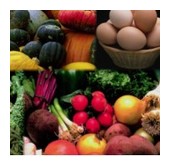Sowing and Reaping
There is a wealth of information on the African-American community and agricultural development in the United States. One of the sources of information used for notes on this page was an article by historian Sharon Ann Holt. "Making Freedom Pay: Freedpeople Working for Themselves, North Carolina, 1865-1900" was published in the Journal of Southern History, May 1994. The article can be found on pages 229-262.
 Gardens
are a common decorative feature of the modern American home. From the
back yard to the front, American families across the nation create gardens
that are often times both functional and decorative. Gardening has become
both a relaxing hobby and an important home improvement feature, or
a perfect spot for entertaining guests.
Gardens
are a common decorative feature of the modern American home. From the
back yard to the front, American families across the nation create gardens
that are often times both functional and decorative. Gardening has become
both a relaxing hobby and an important home improvement feature, or
a perfect spot for entertaining guests.
For the African-American community, the home garden, historically, represented a food source, and a source of additional income, a practical feature of the "yard area" that dated back to slavery and continued on into the first half of the twentieth century.
As noted in previous sections, prior to emancipation, some planters permitted enslaved men and women to cultivate small gardens. The meager portions of food provided by the plantation owner could be supplemented from the vegetables grown in a small yard. Reminiscent of African food ways, black families planted such things as sweet potatoes (a plant similar to the African yam), cabbage, squash, greens, and black-eyed peas (a vegetable originating from Africa). Surplus vegetables and other plants from home gardens were sold at market for cash. The money earned could be used to purchase needed material goods.
 African-American
men and women also used plants from their gardens for medicinal purposes,
a knowledge that was transferred from Africa to life in America.
African-American
men and women also used plants from their gardens for medicinal purposes,
a knowledge that was transferred from Africa to life in America.
After emancipation, many African-Americans still bound to rural areas worked within a system of "tenancy" or as "tenant farmers." Black men and women entered into labor contracts with former plantation owners seeking people to harvest their crops. Laborers were paid subsistence wages, offered a house (or what amounted to small cabins) and a small plot of land.
In an article published in a journal of the Southern Historical Association, historian Sharon Ann Holt wrote: "Any wages due over and above the value of these allowances were generally paid by a note from the landlord, often good for only specific provisions and redeemable only at the local store."
Landlords controlled the timing, the substance, and the method of payment for contract work," wrote Ms. Holt in describing the system of tenant farming and its impact on African American laborers.
 For
rural African-American families, the advantages of engaging in independent
work often made the difference between subsistence living and a gradual
improvement in conditions. The independent marketing of fruits and vegetables
from small farms, or what is known as "truck farming" allowed families
to supplement their household needs. The extra income generated also
allowed families to contribute to community activities, such as the
construction of schools, the growth of church congregations and building
sanctuaries, as well as purchasing their own farmland.
For
rural African-American families, the advantages of engaging in independent
work often made the difference between subsistence living and a gradual
improvement in conditions. The independent marketing of fruits and vegetables
from small farms, or what is known as "truck farming" allowed families
to supplement their household needs. The extra income generated also
allowed families to contribute to community activities, such as the
construction of schools, the growth of church congregations and building
sanctuaries, as well as purchasing their own farmland.
The following links are gathered from other sites on the Internet: